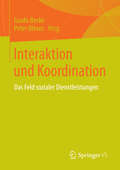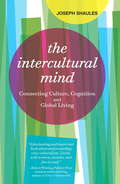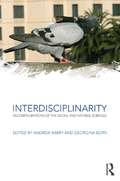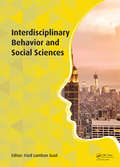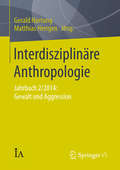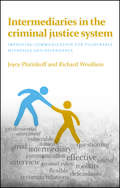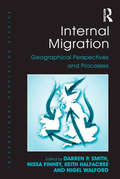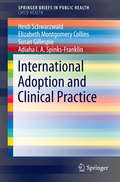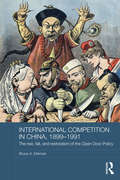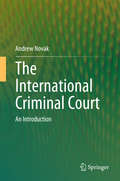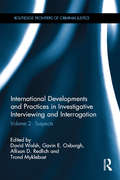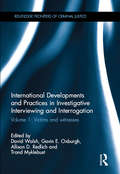- Table View
- List View
Interaktion und Koordination: Das Feld sozialer Dienstleistungen
by Guido Becke Peter BlesesIn diesem Band wird die in der wissenschaftlichen Debatte bislang wenig beachtete Wechselbeziehung zwischen Interaktions- und Koordinationsarbeit am Beispiel sozialer Dienstleistungen beleuchtet: Koordinationsarbeit bildet beispielsweise eine wesentliche Voraussetzung für gelungene Interaktionsarbeit; Koordinationsarbeit beinhaltet selbst auch Interaktionsarbeit. Der Zusammenhang zwischen Interaktions- und Koordinationsarbeit wird in theoretisch-konzeptioneller Hinsicht und auf Basis empirischer Befunde aus verschiedenen Handlungsfeldern sozialer Dienstleistungen hin entfaltet. Auf dieser Grundlage werden Gestaltungsansätze für eine nachhaltige Arbeitsqualität von Interaktions- und Koordinationsarbeit sowie ein erweitertes Produktivitätsverständnis sozialer Dienstleistungen aufgezeigt.
Interaktionen von Fußballfans: Das Spiel am Rande des Spiels
by Martin WinandsMartin Winands untersucht in einer ethnographischen Studie die Interaktionen von Fußballfans im Stadion und entwickelt eine eigene, gegenstandsgegründete Theorie der Interaktionsordnungen. Die Analysen werden maßgeblich von den theoretischen Ausführungen Goffmans beeinflusst, auf deren Basis ein sensibilisierendes Konzept entwickelt wird. Die grundlagenwissenschaftlich angelegte Forschung gibt Impulse für eine theoretisch wie empirisch fundierte Fansozialforschung und es werden analytische Angebote für die handlungsorientierte Fansozialarbeit vorgeschlagen. Die Analysen zeigen, dass die Ultragruppen im Zentrum der Interaktionen stehen und vielerorts die Stimmung in den Stadien von ihnen abhängig ist. Zudem werden autoritäre Muster sichtbar, da die Ultragruppen häufig darüber entscheiden, welche Artikulationen legitim sind und welche nicht.
The Intercultural Mind: Connecting Culture, Cognition, and Global Living
by Joseph ShaulesIn this pioneering book, Joseph Shaules presents exciting new research from cultural psychology and neuroscience. It sheds light on the hidden influence of culture on the unconscious mind, and helps people get more out of their intercultural journeys.The Intercultural Mind presents new perspectives on important questions such as: What is culture shock, and how does it affect us? Why are we blind to our own cultural conditioning? Can cultural differences be measured? What does it mean to have an international mindset? Illustrated with a wealth of examples and memorable stories, The Intercultural Mind is a fascinating look at how intercultural experiences can transform the geography of our minds.
Interdisciplinarity: Reconfigurations of the Social and Natural Sciences (CRESC)
by Andrew Barry Georgina BornThe idea that research should become more interdisciplinary has become commonplace. According to influential commentators, the unprecedented complexity of problems such as climate change or the social implications of biomedicine demand interdisciplinary efforts integrating both the social and natural sciences. In this context, the question of whether a given knowledge practice is too disciplinary, or interdisciplinary, or not disciplinary enough has become an issue for governments, research policy makers and funding agencies. Interdisciplinarity, in short, has emerged as a key political preoccupation; yet the term tends to obscure as much as illuminate the diverse practices gathered under its rubric. This volume offers a new approach to theorising interdisciplinarity, showing how the boundaries between the social and natural sciences are being reconfigured. It examines the current preoccupation with interdisciplinarity, notably the ascendance of a particular discourse in which it is associated with a transformation in the relations between science, technology and society. Contributors address attempts to promote collaboration between, on the one hand, the natural sciences and engineering and, on the other, the social sciences, arts and humanities. From ethnography in the IT industry to science and technology studies, environmental science to medical humanities, cybernetics to art-science, the collection interrogates how interdisciplinarity has come to be seen as a solution not only to enhancing relations between science and society, but the pursuit of accountability and the need to foster innovation. Interdisciplinarity is essential reading for scholars, students and policy makers across the social sciences, arts and humanities, including anthropology, geography, sociology, science and technology studies and cultural studies, as well as all those engaged in interdisciplinary research. It will have particular relevance for those concerned with the knowledge economy, science policy, environmental politics, applied anthropology, ELSI research, medical humanities, and art-science.
Interdisciplinarity: Reconfigurations of the Social and Natural Sciences (CRESC)
by Andrew Barry Georgina BornThe idea that research should become more interdisciplinary has become commonplace. According to influential commentators, the unprecedented complexity of problems such as climate change or the social implications of biomedicine demand interdisciplinary efforts integrating both the social and natural sciences. In this context, the question of whether a given knowledge practice is too disciplinary, or interdisciplinary, or not disciplinary enough has become an issue for governments, research policy makers and funding agencies. Interdisciplinarity, in short, has emerged as a key political preoccupation; yet the term tends to obscure as much as illuminate the diverse practices gathered under its rubric. This volume offers a new approach to theorising interdisciplinarity, showing how the boundaries between the social and natural sciences are being reconfigured. It examines the current preoccupation with interdisciplinarity, notably the ascendance of a particular discourse in which it is associated with a transformation in the relations between science, technology and society. Contributors address attempts to promote collaboration between, on the one hand, the natural sciences and engineering and, on the other, the social sciences, arts and humanities. From ethnography in the IT industry to science and technology studies, environmental science to medical humanities, cybernetics to art-science, the collection interrogates how interdisciplinarity has come to be seen as a solution not only to enhancing relations between science and society, but the pursuit of accountability and the need to foster innovation. Interdisciplinarity is essential reading for scholars, students and policy makers across the social sciences, arts and humanities, including anthropology, geography, sociology, science and technology studies and cultural studies, as well as all those engaged in interdisciplinary research. It will have particular relevance for those concerned with the knowledge economy, science policy, environmental politics, applied anthropology, ELSI research, medical humanities, and art-science.
Interdisciplinary Behavior and Social Sciences: Proceedings of the 3rd International Congress on Interdisciplinary Behavior and Social Science 2014 (ICIBSoS 2014), 1-2 November 2014, Bali, Indonesia.
by Ford Lumban GaolThe human aspect plays an important role in the social sciences. The behavior of people has become a vital area of focus in the social sciences as well. Interdisciplinary Behavior and Social Sciences contains papers that were originally presented at the 3rd International Congress on Interdisciplinary Behavior and Social Science 2014 (ICIBSoS 2014),
Interdisciplining Digital Humanities: Boundary Work in an Emerging Field (Digital Humanities)
by Julie T KleinInterdisciplining Digital Humanities sorts through definitions and patterns of practice over roughly sixty-five years of work, providing an overview for specialists and a general audience alike. It is the only book that tests the widespread claim that Digital Humanities is interdisciplinary. By examining the boundary work of constructing, expanding, and sustaining a new field, it depicts both the ways this new field is being situated within individual domains and dynamic cross-fertilizations that are fostering new relationships across academic boundaries. It also accounts for digital reinvigorations of “public humanities” in cultural heritage institutions of museums, archives, libraries, and community forums.
Interdisziplinäre Anthropologie: Jahrbuch 2/2014: Gewalt und Aggression (Interdisziplinäre Anthropologie)
by Gerald Hartung Matthias HerrgenGewalt und Aggression gehören zu den zentralen Problemen der Anthropologie. Dieser Band versammelt Beiträge von Natur-, Geistes und Sozialwissenschaftlern, um einen interdisziplinären Dialog zum Thema Gewalt zu eröffnen. Der Diskursteil enthält einen Hauptbeitrag aus sozialpsychologischer Perspektive, Kommentare aus unterschiedlichen Fachgebieten und eine Replik der Autorin. Zusätzliche Forschungsbeiträge erweitern den Themenschwerpunkt des Bandes. Komplettiert wird das Jahrbuch mit den Rubriken „Beiträge“, „Berichte“, „Rezensionen“ und „Kalender“, die allesamt Beiträge zur Diskussionslandschaft einer Interdisziplinären Anthropologie bieten.
The Interface Envelope: Gaming, Technology, Power
by James AshIn The Interface Envelope, James Ash develops a series of concepts to understand how digital interfaces work to shape the spatial and temporal perception of players. Drawing upon examples from videogame design and work from post-phenomenology, speculative realism, new materialism and media theory, Ash argues that interfaces create envelopes, or localised foldings of space time, around which bodily and perceptual capacities are organised for the explicit production of economic profit. Modifying and developing Bernard Stiegler's account of psychopower and Warren Neidich's account of neuropower, Ash argues the aim of interface designers and publishers is the production of envelope power. Envelope power refers to the ways that interfaces in games are designed to increase users perceptual and habitual capacities to sense difference. Examining a range of examples from specific videogames, Ash identities a series of logics that are key to producing envelope power and shows how these logics have intensified over the last thirty years. In turn, Ash suggests that the logics of interface envelopes in videogames are spreading to other types of interface. In doing so life becomes enveloped as the environments people inhabit becoming increasingly loaded with digital interfaces. Rather than simply negative, Ash develops a series of responses to the potential problematics of interface envelopes and envelope power and emphasizes their pharmacological nature.
The Interface Envelope: Gaming, Technology, Power
by James AshIn The Interface Envelope, James Ash develops a series of concepts to understand how digital interfaces work to shape the spatial and temporal perception of players. Drawing upon examples from videogame design and work from post-phenomenology, speculative realism, new materialism and media theory, Ash argues that interfaces create envelopes, or localised foldings of space time, around which bodily and perceptual capacities are organised for the explicit production of economic profit. Modifying and developing Bernard Stiegler's account of psychopower and Warren Neidich's account of neuropower, Ash argues the aim of interface designers and publishers is the production of envelope power. Envelope power refers to the ways that interfaces in games are designed to increase users perceptual and habitual capacities to sense difference. Examining a range of examples from specific videogames, Ash identities a series of logics that are key to producing envelope power and shows how these logics have intensified over the last thirty years. In turn, Ash suggests that the logics of interface envelopes in videogames are spreading to other types of interface. In doing so life becomes enveloped as the environments people inhabit becoming increasingly loaded with digital interfaces. Rather than simply negative, Ash develops a series of responses to the potential problematics of interface envelopes and envelope power and emphasizes their pharmacological nature.
Intermarriage and Mixed Parenting, Promoting Mental Health and Wellbeing: Crossover Love
by R. SinglaMarriages across ethnic borders are increasing in frequency, yet little is known of how discourses of 'normal' families, ethnicity, race, migration, globalisation affect couples and children involved in these mixed marriages. This book explores mixed marriage though intimate stories drawn from the real lives of visibly different couples.
Intermediaries in the criminal justice system: Improving communication for vulnerable witnesses and defendants
by Joyce Plotnikoff Richard WoolfsonThis is the first book about the intermediary scheme, criminal justice’s untold ‘good news story’. Intermediaries are independent communication specialists who assist children and vulnerable adults at police interviews and trials, helping to improve the quality of their evidence and providing access to justice for those who previously had been excluded. Richly illustrated with case examples through intermediaries’ own descriptions of their work, the book also includes feedback from justice system personnel and over 70 judges. This unique book provides a comprehensive explanation of how intermediaries work in practice and gives ‘behind the scenes’ insights into the criminal process. It will be of interest to practitioners and the wider public in England and Wales and encourage consideration of the scheme elsewhere.
Intermediaries in the criminal justice system: Improving communication for vulnerable witnesses and defendants
by Joyce Plotnikoff Richard WoolfsonThis is the first book about the intermediary scheme, criminal justice’s untold ‘good news story’. Intermediaries are independent communication specialists who assist children and vulnerable adults at police interviews and trials, helping to improve the quality of their evidence and providing access to justice for those who previously had been excluded. Richly illustrated with case examples through intermediaries’ own descriptions of their work, the book also includes feedback from justice system personnel and over 70 judges. This unique book provides a comprehensive explanation of how intermediaries work in practice and gives ‘behind the scenes’ insights into the criminal process. It will be of interest to practitioners and the wider public in England and Wales and encourage consideration of the scheme elsewhere.
Internal Migration: Geographical Perspectives and Processes (International Population Studies)
by Nigel Walford Nissa Finney Darren P. SmithOver the last two decades there have been numerous profound changes in UK society which have had an impact on the scale, geographies, meaning and experiences of internal migration. Providing a critical appraisal of migration scholarship from the perspective of Geography, reviewing theory, substantive foci and method, this book demonstrates how sub-national migration in the UK gives rise to and reflects new patterns of population, housing, economies and cultures. Each chapter is written by a Population Geographer together with a scholar representing another Human Geography sub-discipline thus providing a cross-disciplinary perspective on a specific aspect of migration. Critically reviewing and setting an agenda for internal migration scholarship from a spatial perspective, this book will be of interest to academics and students of Geography and other disciplines concerned with migration, both within the UK and further afield.
Internal Migration: Geographical Perspectives and Processes (International Population Studies)
by Nigel Walford Nissa Finney Darren P. SmithOver the last two decades there have been numerous profound changes in UK society which have had an impact on the scale, geographies, meaning and experiences of internal migration. Providing a critical appraisal of migration scholarship from the perspective of Geography, reviewing theory, substantive foci and method, this book demonstrates how sub-national migration in the UK gives rise to and reflects new patterns of population, housing, economies and cultures. Each chapter is written by a Population Geographer together with a scholar representing another Human Geography sub-discipline thus providing a cross-disciplinary perspective on a specific aspect of migration. Critically reviewing and setting an agenda for internal migration scholarship from a spatial perspective, this book will be of interest to academics and students of Geography and other disciplines concerned with migration, both within the UK and further afield.
International Adoption and Clinical Practice (SpringerBriefs in Public Health #0)
by Heidi Schwarzwald Elizabeth Montgomery Collins Susan Gillespie Adiaha I. Spinks-FranklinNo matter how positive the intent of prospective parents, international adoption is fraught with emotional, medical, administrative, linguistic, and geopolitical issues. And while a wide range of professionals supports adopted children and their families in adjusting to the inherent changes and disruptions, the pediatrician's tasks--identifying and treating existing health problems and preventing numerous others--are particularly complex. International Adoption and Clinical Practice equips pediatricians with a comprehensive set of tools for establishing a long-term care plan and creating interventions to promote healthy development. This concise guide overviews the intricacies of the international adoption process and how they can affect the pediatrician's job, from potential pitfalls in collecting medical data from a child's birth country to tracking health concerns into adolescence and young adulthood. Developmental and behavioral issues including attachment, language acquisition, identity development, and consequences of abuse and neglect are also examined in this context. Figures, tables, and reference lists complement current information on topics such as:Epidemiology and demographics of international adoption.Pre-adoption evaluation of medical records.Guidelines for diagnostic testing, screening, laboratory evaluations, and immunizations.Common mental health issues faced by adopted children and their families.Long-term and adult outcomes of international adoption.Relevant policy issues and areas for future study. Every child deserves a safe and healthy home, and International Adoption and Clinical Practice gives pediatricians an in-depth framework for helping to make this possible as children make the transition to a new country and the next stage of their lives.
International Competition in China, 1899-1991: The Rise, Fall, and Restoration of the Open Door Policy (Routledge Studies in the Modern History of Asia)
by Bruce A. EllemanChina's recent economic reforms have opened its economy to the world. This policy, however, is not new: in the late nineteenth century, the United States put forward the Open Door Policy as a counter to European exclusive 'spheres of influence' in China. This book, based on extensive original archival research, examines and re-evaluates China's Open Door Policy. It considers the policy from its inception in 1899 right through to the post-1978 reforms. It relates these changes to the various shifts in China’s international relations, discusses how decades of foreign invasion, civil war and revolution followed the destruction of the policy in the 1920s, and considers how the policy, when applied in Taiwan after 1949, and by Deng Xiaoping in mainland China after 1978, was instrumental in bringing about, respectively, Taiwan's 'economic miracle' and mainland China’s recent economic boom. The book argues that, although the policy was characterised as United States 'economic imperialism' during the Cold War, in reality it helped China retain its sovereignty and territorial integrity.
International Competition in China, 1899-1991: The Rise, Fall, and Restoration of the Open Door Policy (Routledge Studies in the Modern History of Asia)
by Bruce A. EllemanChina's recent economic reforms have opened its economy to the world. This policy, however, is not new: in the late nineteenth century, the United States put forward the Open Door Policy as a counter to European exclusive 'spheres of influence' in China. This book, based on extensive original archival research, examines and re-evaluates China's Open Door Policy. It considers the policy from its inception in 1899 right through to the post-1978 reforms. It relates these changes to the various shifts in China’s international relations, discusses how decades of foreign invasion, civil war and revolution followed the destruction of the policy in the 1920s, and considers how the policy, when applied in Taiwan after 1949, and by Deng Xiaoping in mainland China after 1978, was instrumental in bringing about, respectively, Taiwan's 'economic miracle' and mainland China’s recent economic boom. The book argues that, although the policy was characterised as United States 'economic imperialism' during the Cold War, in reality it helped China retain its sovereignty and territorial integrity.
The International Criminal Court: An Introduction (SpringerBriefs in Law)
by Andrew NovakThis book is about the International Criminal Court (ICC), a new and highly distinctive criminal justice institution with the ability to prosecute the highest-level government officials, including heads of state, even in countries that have not accepted its jurisdiction. The book explores the historical development of international criminal law and the formal legal structure created by the Rome Statute, against the background of the Court’s search for objectivity in a political global environment. The book reviews the operations of the Court in practice and the Court’s position in the power politics of the international system. It discusses and clarifies all stages of an international criminal proceeding from the opening of the investigation to sentencing, reparations, and final appeals in the context of its restorative justice mission. Making appropriate comparisons and contrasts between the international criminal justice system and domestic and national systems, the book fills a gap in international criminal justice study.
International Developments and Practices in Investigative Interviewing and Interrogation: Volume 2: Suspects (Routledge Frontiers of Criminal Justice)
by David Walsh Gavin E. Oxburgh Alison D. Redlich Trond MyklebustTechniques in the investigative interviewing and interrogation of victims, witnesses and suspects of crime vary around the world, according to a country’s individual legal system, religion and culture. Whereas some countries have developed certain interview protocols for witnesses (such as the ABE Guidelines and the NICHD protocol when interviewing children) and the PEACE model of interviewing suspects, other countries continue to use physical coercion and other questionable tactics to elicit information. Until now, there has been very little empirical information about the overall interview and interrogation practices in non-western countries, especially the Middle and Far East. This book addresses this gap, bringing together international experts from over 25 countries and providing in-depth coverage of the various interview and interrogation techniques used across the globe. Volume 2 focuses on the interviewing of crime suspects, aiming to provide the necessary information for an understanding of how law enforcement agencies around the world gain valuable information from suspects in criminal cases. Together, the chapters that make up this volume and the accompanying volume on interviewing witnesses and victims, draw on specific national case studies and practices, examine contemporary challenges and identify best practice to enable readers to develop an international, as well as a comparative, perspective of developments worldwide in this important area of criminal investigation. This book will be an essential resource for academics and students engaged in the study of policing, criminal investigation, forensic psychology and criminal law. It will also be of great interest to practitioners, legal professionals and policymakers around the world.
International Developments and Practices in Investigative Interviewing and Interrogation: Volume 2: Suspects (Routledge Frontiers of Criminal Justice)
by David Walsh Gavin E. Oxburgh Allison D. Redlich Trond MyklebustTechniques in the investigative interviewing and interrogation of victims, witnesses and suspects of crime vary around the world, according to a country’s individual legal system, religion and culture. Whereas some countries have developed certain interview protocols for witnesses (such as the ABE Guidelines and the NICHD protocol when interviewing children) and the PEACE model of interviewing suspects, other countries continue to use physical coercion and other questionable tactics to elicit information. Until now, there has been very little empirical information about the overall interview and interrogation practices in non-western countries, especially the Middle and Far East. This book addresses this gap, bringing together international experts from over 25 countries and providing in-depth coverage of the various interview and interrogation techniques used across the globe. Volume 2 focuses on the interviewing of crime suspects, aiming to provide the necessary information for an understanding of how law enforcement agencies around the world gain valuable information from suspects in criminal cases. Together, the chapters that make up this volume and the accompanying volume on interviewing witnesses and victims, draw on specific national case studies and practices, examine contemporary challenges and identify best practice to enable readers to develop an international, as well as a comparative, perspective of developments worldwide in this important area of criminal investigation. This book will be an essential resource for academics and students engaged in the study of policing, criminal investigation, forensic psychology and criminal law. It will also be of great interest to practitioners, legal professionals and policymakers around the world.
International Developments and Practices in Investigative Interviewing and Interrogation: Volume 1: Victims and witnesses (Routledge Frontiers of Criminal Justice)
by David Walsh Gavin E. Oxburgh Alison D. Redlich Trond MyklebustTechniques in the investigative interviewing and interrogation of victims, witnesses and suspects of crime vary around the world, according to a country’s individual legal system, religion and culture. Whereas some countries have developed certain interview protocols for witnesses (such as the ABE Guidelines and the NICHD protocol when interviewing children) and the PEACE model of interviewing suspects, other countries continue to use physical coercion and other questionable tactics to elicit information. Until now, there has been very little empirical information about the overall interview and interrogation practices in non-western countries, especially the Middle and Far East. This book addresses this gap, bringing together international experts from over 25 countries and providing in-depth coverage of the various interview and interrogation techniques used across the globe. Volume 1 focuses on the interviewing of victims and witnesses, aiming to provide the necessary information for an understanding of how law enforcement agencies around the world gain valuable information from victims and witnesses in criminal cases. Together, the chapters that make up this volume and the accompanying volume on interviewing suspects, draw on specific national case studies and practices, examine contemporary challenges and identify best practice to enable readers to develop an international, as well as a comparative, perspective of developments worldwide in this important area of criminal investigation. This book will be an essential resource for academics and students engaged in the study of policing, criminal investigation, forensic psychology and criminal law. It will also be of great interest to practitioners, legal professionals and policymakers around the world.
International Developments and Practices in Investigative Interviewing and Interrogation: Volume 1: Victims and witnesses (Routledge Frontiers of Criminal Justice)
by David Walsh Gavin E. Oxburgh Allison D. Redlich Trond MyklebustTechniques in the investigative interviewing and interrogation of victims, witnesses and suspects of crime vary around the world, according to a country’s individual legal system, religion and culture. Whereas some countries have developed certain interview protocols for witnesses (such as the ABE Guidelines and the NICHD protocol when interviewing children) and the PEACE model of interviewing suspects, other countries continue to use physical coercion and other questionable tactics to elicit information. Until now, there has been very little empirical information about the overall interview and interrogation practices in non-western countries, especially the Middle and Far East. This book addresses this gap, bringing together international experts from over 25 countries and providing in-depth coverage of the various interview and interrogation techniques used across the globe. Volume 1 focuses on the interviewing of victims and witnesses, aiming to provide the necessary information for an understanding of how law enforcement agencies around the world gain valuable information from victims and witnesses in criminal cases. Together, the chapters that make up this volume and the accompanying volume on interviewing suspects, draw on specific national case studies and practices, examine contemporary challenges and identify best practice to enable readers to develop an international, as well as a comparative, perspective of developments worldwide in this important area of criminal investigation. This book will be an essential resource for academics and students engaged in the study of policing, criminal investigation, forensic psychology and criminal law. It will also be of great interest to practitioners, legal professionals and policymakers around the world.
The International Film Business: A Market Guide Beyond Hollywood
by Angus FinneyThe International Film Business examines the independent film sector as a business, and addresses the specific skills and knowledge it demands. It describes both the present state of the industry, the significant digital and social media developments that are continuing to take place, and what changes these might effect. The International Film Business: describes and analyses the present structure of the film industry as a business, with a specific focus on the film value chain discusses and analyses current digital technology and how it potentially may change the structure and opportunities offered by the industry in the future provides information and advice on the different business and management skills and strategies includes case studies on a variety of films including The Guard (2011), The King’s Speech (2010), The Best Exotic Marigold Hotel (2012), Cloverfield (2008), Pobby & Dingan (aka Opal Dream, 2005), Confessions of a Dangerous Mind (2002), The Reckoning (2002)and The Mother (2003), and company case studies on Pixar, Renaissance, Redbus and Zentropa. Further case studies on films that failed to go into production include Neil LaBute’s Vapor and Terry Gilliam’s Good Omens. Taking an entrepreneurial perspective on what future opportunities will be available to prepared and informed students and emerging practitioners, this text includes case studies that take students through the successes and failures of a variety of real film companies and projects and features exclusive interviews with leading practitioners in all sectors of the industry, from production to exhibition.
The International Film Business: A Market Guide Beyond Hollywood
by Angus FinneyThe International Film Business examines the independent film sector as a business, and addresses the specific skills and knowledge it demands. It describes both the present state of the industry, the significant digital and social media developments that are continuing to take place, and what changes these might effect. The International Film Business: describes and analyses the present structure of the film industry as a business, with a specific focus on the film value chain discusses and analyses current digital technology and how it potentially may change the structure and opportunities offered by the industry in the future provides information and advice on the different business and management skills and strategies includes case studies on a variety of films including The Guard (2011), The King’s Speech (2010), The Best Exotic Marigold Hotel (2012), Cloverfield (2008), Pobby & Dingan (aka Opal Dream, 2005), Confessions of a Dangerous Mind (2002), The Reckoning (2002)and The Mother (2003), and company case studies on Pixar, Renaissance, Redbus and Zentropa. Further case studies on films that failed to go into production include Neil LaBute’s Vapor and Terry Gilliam’s Good Omens. Taking an entrepreneurial perspective on what future opportunities will be available to prepared and informed students and emerging practitioners, this text includes case studies that take students through the successes and failures of a variety of real film companies and projects and features exclusive interviews with leading practitioners in all sectors of the industry, from production to exhibition.
